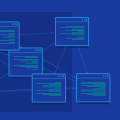Lisp is one of the oldest, most powerful, and most popular programming languages in existence. Developed in 1958, it has a long history of being used for applications ranging from artificial intelligence to web development. It is a functional language, meaning that it uses functions to manipulate data, and it is also highly extensible, making it an ideal language for creating complex applications. In this article, we will delve into the origins of Lisp and its current applications, as well as provide a comprehensive overview of its capabilities and advantages in the world of ERLANG and Lisp is one of the oldest, most powerful, and most popular programming languages in existence. Developed in 1958, it has a long history of being used for applications ranging from artificial intelligence to web development. It is a functional language, meaning that it uses functions to manipulate data, and it is also highly extensible, making it an ideal language for creating complex applications. In this article, we will delve into the origins of Lisp and its current applications, as well as provide a comprehensive overview of its capabilities and advantages in the world of ERLANG and haskell. Lisp is one of the oldest, most powerful, and most popular programming languages in existence. Developed in 1958, it has a long history of being used for applications ranging from artificial intelligence to web development. It is a functional language, meaning that it uses functions to manipulate data, and it is also highly extensible, making it an ideal language for creating complex applications. In this article, we will delve into the origins of Lisp and its current applications, as well as provide a comprehensive overview of its capabilities and advantages in the world of ERLANG and haskell.
Additionally, we will discuss the availability of Profs online r tutors for those who wish to learn more about Lisp. Additionally, we will discuss the availability of Profs online r tutors for those who wish to learn more about Lisp.
Applications of Lisp
The power of Lisp lies in its ability to be used in a variety of different applications. From artificial intelligence to web programming and game development, Lisp has been used in a number of different contexts, including haskell. In terms of artificial intelligence, Lisp is used to create algorithms and program agents that can learn from their environment and interact with it. Through the use of Lisp-based tools such as CL-AI, developers can create intelligent agents that are able to learn from their environment and make decisions. In the world of web programming, Lisp is used to create dynamic web applications that can be easily maintained and updated. Lisp provides developers with powerful tools for creating complex web applications that are reliable, scalable, and easy to use. Finally, Lisp is also used for game development.By using the powerful features of Lisp, developers can create games that are both entertaining and challenging. Lisp provides developers with the ability to create complex game logic, which makes it a great choice for game development.
Limitations of Lisp
Although Lisp has a lot of advantages, it also has some limitations. One issue that is often mentioned is that Lisp programs can be difficult to debug and maintain, due to its complex syntax and the fact that it does not have any built-in debugging tools. This can make it difficult for new programmers to learn the language, as well as for experienced programmers to debug and maintain existing code.Another limitation is that Lisp is not as efficient as other languages, such as C++, when it comes to running time-critical applications. Additionally, Lisp is not well suited for writing large-scale applications, as the complexity of the language makes this difficult. Finally, Lisp does not have good support for object-oriented programming (OOP), which can make it difficult to use in a modern software development environment. While there are libraries and frameworks available to help with this, they are not as comprehensive or intuitive as those provided by other languages.
Features of Lisp
Lisp is a high-level functional programming language, which means that it provides a set of functions for expressing algorithms in a concise way. It is well known for its ability to process symbolic data, as well as its powerful metaprogramming capabilities.Lisp has a number of features that make it unique from other programming languages.
Syntactic Abstraction:
Lisp allows users to define abstractions of code, which can be reused throughout the program. This helps reduce complexity and improves maintainability.Dynamic Typing:
Lisp does not require the programmer to declare the type of data before using it.Instead, the type of data is determined at run time. This makes it easier to write code quickly and efficiently.
Macros:
Lisp has an advanced macro system that allows users to extend the language in powerful ways. With macros, users can define new syntactic forms or modify existing ones.Garbage Collection: Lisp automatically manages memory, freeing up resources and reducing the amount of memory overhead associated with programs. This allows programmers to focus on developing their applications instead of worrying about managing memory.
Examples of Lisp in Use
Lisp has been used in a variety of applications over the years, from enterprise software to artificial intelligence. Some examples of Lisp being used in a practical way are as follows:Enterprise SoftwareBusinesses often use Lisp to develop sophisticated software. Lisp was used to develop enterprise software like the popular Lotus Notes and the Oracle database. Businesses often use Lisp to develop sophisticated software. Lisp was used to develop enterprise software like the popular Lotus Notes and the Oracle database.Artificial Intelligence
Lisp is also used in Artificial Intelligence (AI) research, as it provides powerful tools for manipulating symbols and data structures.AI researchers have used Lisp to create expert systems, natural language processing systems, and computer vision systems. AI researchers have used Lisp to create expert systems, natural language processing systems, and computer vision systems.
Game Development
Lisp is also used for game development, as it provides a powerful programming language that can be used to develop games with complex logic and graphics. The popular game Doom was written in Lisp, and more recently, popular games like World of Warcraft have also been written in Lisp.Web Development
Finally, Lisp has also been used in web development. It is used to develop dynamic websites and web applications, as well as for server-side scripting.Benefits of Lisp
Lisp is an incredibly powerful programming language, with a wide variety of benefits that make it one of the most popular languages for software development. Lisp offers a dynamic, high-level approach to programming which makes it easier to write complex programs quickly and maintain existing code. One of the main advantages of Lisp is its flexibility.It can be used for both procedural and functional programming, allowing developers to write code in whatever style best suits their projects. Lisp also has powerful debugging capabilities, making it easier to identify and fix errors in code. Another benefit of Lisp is that it is highly extensible. Developers can easily add their own functions and data types to extend the language.
This allows them to create custom solutions that are tailored to their specific needs. Finally, Lisp is highly portable, meaning it can be used on multiple platforms without needing to rewrite the code. This makes it ideal for creating applications that can run on different operating systems. Overall, Lisp is an incredibly versatile and powerful language that offers a variety of benefits for developers.
Its flexibility, extensibility, and portability make it a great choice for a wide range of projects.
History of Lisp
Lisp has been around for over six decades and is considered one of the oldest programming languages still in use today. It was first developed by John McCarthy in 1958 while he was at MIT, originally as a tool to explore the development of artificial intelligence. The name Lisp was derived from “List Processing”, which is an appropriate description of the language because it is heavily reliant on list data structures. Lisp was initially used by McCarthy and his team to develop the first version of AI software. It was then used by many other computer scientists over the years and has had a significant impact on the development of modern programming languages. Lisp is a functional programming language, meaning that it works by transforming data rather than performing operations. Lisp has been around for over six decades and is considered one of the oldest programming languages still in use today. It was first developed by John McCarthy in 1958 while he was at MIT, originally as a tool to explore the development of artificial intelligence. The name Lisp was derived from “List Processing”, which is an appropriate description of the language because it is heavily reliant on list data structures. Lisp was initially used by McCarthy and his team to develop the first version of AI software. It was then used by many other computer scientists over the years and has had a significant impact on the development of modern programming languages. Lisp is a functional programming language, meaning that it works by transforming data rather than performing operations.This means that Lisp programs are able to work with data in a much more efficient way than traditional procedural languages. In addition, Lisp is an interpreted language, meaning that its programs can be written and executed quickly without needing to be compiled. Lisp has been used in many different areas, including artificial intelligence, robotics, natural language processing, and general-purpose programming. Its syntax is simple and concise, making it relatively easy to learn. Lisp has also been the source of inspiration for many modern programming languages such as Clojure and Scheme. This means that Lisp programs are able to work with data in a much more efficient way than traditional procedural languages. In addition, Lisp is an interpreted language, meaning that its programs can be written and executed quickly without needing to be compiled. Lisp has been used in many different areas, including artificial intelligence, robotics, natural language processing, and general-purpose programming. Its syntax is simple and concise, making it relatively easy to learn. Lisp has also been the source of inspiration for many modern programming languages such as Clojure and Scheme.
Future of Lisp
Lisp has been around for over six decades, and its longevity speaks to its usefulness and relevance in modern times.Despite its age, Lisp remains a popular language amongst programmers and developers, and is often used in artificial intelligence applications due to its ability to easily handle complex data structures. Despite its advantages, Lisp has not seen the same level of popularity as other languages. This is mainly due to its lack of support for certain modern features such as object-oriented programming. However, the future of Lisp looks bright. Many new libraries and frameworks have been released to make Lisp more accessible and user-friendly.
Additionally, new development tools have been created to help developers create more powerful applications with Lisp. As a result, the language is becoming more popular, and it is likely to remain so in the future. Lisp is also seeing a resurgence in the research community. It's being used in areas such as natural language processing and machine learning. This is due to Lisp's flexibility and ability to quickly process data.
As these fields continue to grow, so will the use of Lisp. Finally, many companies are embracing Lisp as a viable language for their development projects. This is due to its cost-effectiveness and ability to quickly develop applications with fewer resources. In addition, many companies have begun implementing Lisp into their existing development environments, which gives them more flexibility and control. Overall, Lisp is a powerful language with a bright future. Its advantages make it an attractive choice for developers looking for a reliable, versatile language for their projects.
With the right tools and libraries, Lisp can be used to create powerful applications and make development much easier. Lisp is a powerful and versatile programming language that has stood the test of time for over six decades. Its features make it ideal for many applications, from web development to data science and artificial intelligence. Its benefits include easy readability and extensibility, which makes it an attractive choice for developers of all skill levels. Examples of Lisp in use demonstrate its effectiveness in various fields, such as machine learning, robotics, and scientific computing.
Despite some of its limitations, Lisp remains a popular language that is likely to remain in use for many years to come.











